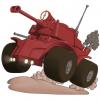Hello! ![]()
I am planning to program a Yu-Gi-Oh! card game for Windows Operating System. See this link for more info about Yu-Gi-Oh!: http://en.wikipedia.org/wiki/Yu-Gi-Oh!_Trading_Card_Game
I'd like to start with the game YGOPRO. See this link about the game: http://ygopro.co. I have the game installed on my PC and enjoys playing it! ![]() I'm really trying to learn how the game was programmed by checking each files from the game source, viewing them on a text editor, so on...
I'm really trying to learn how the game was programmed by checking each files from the game source, viewing them on a text editor, so on...
Starting with card scripting.
Images of the game:





The card's database, where the names and information of the cards are saved, and their scripts, the actions performed based on the card's description when it's triggered. I don't have an idea how they were executed and performed when the cards are used within the game.
I picked up a card to be an example named The Gates of Dark World.
Here's the file and image for the card's database (cards.cdb): https://www.dropbox.com/s/2uow819ay7zl11g/cards.cdb?dl=0


Within the game:

File for the card's scripts (c33017655.lua): https://www.dropbox.com/s/4nru2mtufe9c75f/c33017655.lua?dl=0
--?????
function c33017655.initial_effect(c)
--Activate
local e1=Effect.CreateEffect(c)
e1:SetType(EFFECT_TYPE_ACTIVATE)
e1:SetCode(EVENT_FREE_CHAIN)
c:RegisterEffect(e1)
--atkup
local e2=Effect.CreateEffect(c)
e2:SetType(EFFECT_TYPE_FIELD)
e2:SetCode(EFFECT_UPDATE_ATTACK)
e2:SetRange(LOCATION_SZONE)
e2:SetTargetRange(LOCATION_MZONE,LOCATION_MZONE)
e2:SetTarget(aux.TargetBoolFunction(Card.IsRace,RACE_FIEND))
e2:SetValue(300)
c:RegisterEffect(e2)
--defup
local e3=Effect.CreateEffect(c)
e3:SetType(EFFECT_TYPE_FIELD)
e3:SetCode(EFFECT_UPDATE_DEFENCE)
e3:SetRange(LOCATION_SZONE)
e3:SetTargetRange(LOCATION_MZONE,LOCATION_MZONE)
e3:SetTarget(aux.TargetBoolFunction(Card.IsRace,RACE_FIEND))
e3:SetValue(300)
c:RegisterEffect(e3)
--discard & draw
local e4=Effect.CreateEffect(c)
e4:SetCategory(CATEGORY_HANDES+CATEGORY_DRAW)
e4:SetDescription(aux.Stringid(33017655,1))
e4:SetType(EFFECT_TYPE_IGNITION)
e4:SetRange(LOCATION_SZONE)
e4:SetCountLimit(1)
e4:SetCost(c33017655.cost)
e4:SetTarget(c33017655.target)
e4:SetOperation(c33017655.operation)
c:RegisterEffect(e4)
end
function c33017655.costfilter(c)
return c:IsRace(RACE_FIEND) and c:IsAbleToRemoveAsCost()
end
function c33017655.cost(e,tp,eg,ep,ev,re,r,rp,chk)
if chk==0 then return Duel.IsExistingMatchingCard(c33017655.costfilter,tp,LOCATION_GRAVE,0,1,nil) end
Duel.Hint(HINT_SELECTMSG,tp,HINTMSG_REMOVE)
local g=Duel.SelectMatchingCard(tp,c33017655.costfilter,tp,LOCATION_GRAVE,0,1,1,nil)
Duel.Remove(g,POS_FACEUP,REASON_COST)
end
function c33017655.target(e,tp,eg,ep,ev,re,r,rp,chk)
if chk==0 then return Duel.IsExistingMatchingCard(Card.IsRace,tp,LOCATION_HAND,0,1,nil,RACE_FIEND)
and Duel.IsPlayerCanDraw(tp,1) end
Duel.SetOperationInfo(0,CATEGORY_HANDES,nil,0,tp,1)
Duel.SetOperationInfo(0,CATEGORY_DRAW,nil,0,tp,1)
end
function c33017655.operation(e,tp,eg,ep,ev,re,r,rp,chk)
if not e:GetHandler():IsRelateToEffect(e) then return end
Duel.Hint(HINT_SELECTMSG,tp,HINTMSG_DISCARD)
local g=Duel.SelectMatchingCard(tp,Card.IsRace,tp,LOCATION_HAND,0,1,1,nil,RACE_FIEND)
if g:GetCount()>0 then
Duel.SendtoGrave(g,REASON_EFFECT+REASON_DISCARD)
Duel.BreakEffect()
Duel.Draw(tp,1,REASON_EFFECT)
end
end
Here are the other files from the game source:
(lflist.conf) - https://www.dropbox.com/s/ivdbyy11ql5vg17/lflist.conf?dl=0
(strings.conf) - https://www.dropbox.com/s/bcl7ymeyf8hy33k/strings.conf?dl=0
(system.conf) - https://www.dropbox.com/s/er3ay621jvn0qrn/system.conf?dl=0
I want to know how the two files work; the cads.cdb & c33017655.lua
And what programming language is a .lua file?!
Anyone who knows?
I need more explanations!
Thanks ~ ! ![]()












